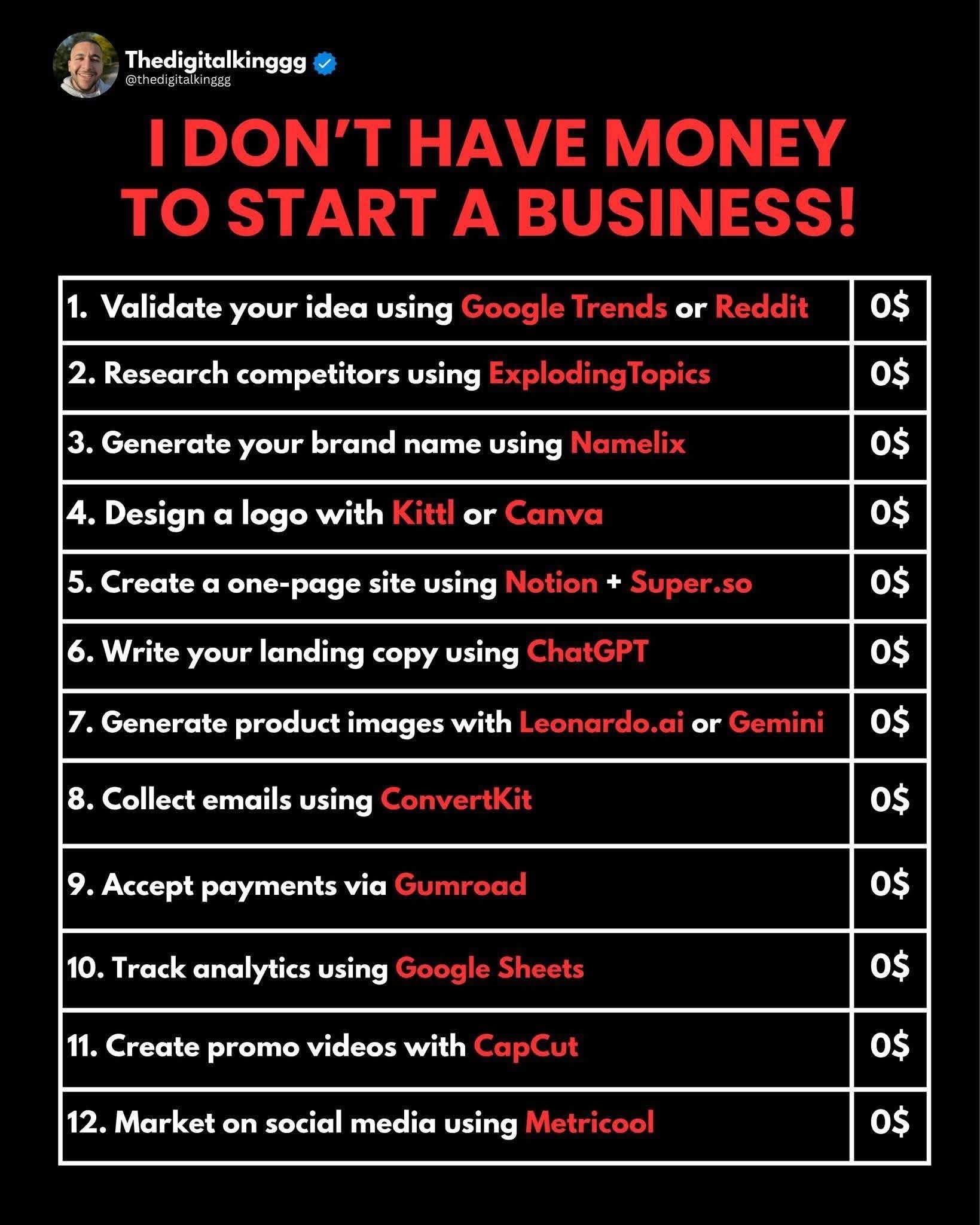46 mins. ago
(E)
Put this prompt into any ai llm.
“I want to build a million-dollar business in the next 6 months using AI with zero startup costs.
Personalize this plan to me: I’m [describe your background, e.g. ‘a digital marketer and content creator with experience in online courses, brand strategy, and automation’].
I want the business to:
• Leverage AI tools to maximize automation and scalability.
• Require little to no upfront cash investment.
• Be aligned with my strengths, interests, and existing audience.
• Generate at least $1M in gross revenue within 6 months.
Give me:
1. Three specific business models that fit my background and goals.
2. A step-by-step 6-month roadmap for the best idea.
3. The AI tools, automations, and outsourcing workflows to make it happen.
GENERATE AT LEAST 1 MILLION IN GROSS REVENUE WITHIN SIX MONTHS.”
“I want to build a million-dollar business in the next 6 months using AI with zero startup costs.
Personalize this plan to me: I’m [describe your background, e.g. ‘a digital marketer and content creator with experience in online courses, brand strategy, and automation’].
I want the business to:
• Leverage AI tools to maximize automation and scalability.
• Require little to no upfront cash investment.
• Be aligned with my strengths, interests, and existing audience.
• Generate at least $1M in gross revenue within 6 months.
Give me:
1. Three specific business models that fit my background and goals.
2. A step-by-step 6-month roadmap for the best idea.
3. The AI tools, automations, and outsourcing workflows to make it happen.
GENERATE AT LEAST 1 MILLION IN GROSS REVENUE WITHIN SIX MONTHS.”
11 hours ago
We are selling this laptop on ebay.
https://www.ebay.com/itm/3...
https://www.ebay.com/itm/3...

Dell Latitude PRO 14 RUGGED RB14250 Ultra 7 165U 2TB 32GB CMRA BKLT GPS PRO WTY | eBay
Find many great new & used options and get the best deals for Dell Latitude PRO 14 RUGGED RB14250 Ultra 7 165U 2TB 32GB CMRA BKLT GPS PRO WTY at the best online prices at eBay! Free shipping for many products!
https://www.ebay.com/itm/357947478525
14 hours ago
I remember when I learned that taking baking soda pills in the morning helps a lot. There’s also a soursop fanbendesol ivermectin, which is horse dewormer. Which believe it or not takes out all of your parasites that you have inside of your body inside of your stomach, which is also another cost for cancer that people don’t realize.
There are alternatives to chemotherapy. I know all of the doctors like to do chemotherapy but if you can not do it, there are definitely alternatives that work where you don’t have to throw up in the middle of the night from the having the chemo that day.
There are alternatives to chemotherapy. I know all of the doctors like to do chemotherapy but if you can not do it, there are definitely alternatives that work where you don’t have to throw up in the middle of the night from the having the chemo that day.
14 hours ago
The thing with cancer is that there’s multiple different cancers so one remedy might not work for your type of cancer, but the main thing about cancer is that if you do have cancer, that means that your system is in an acid state so that means that your pH level is below what the norm is which I think is 7.4 whatever so if you raise your pH level to anywhere, you know 89.5 you’re in a what they call alkaline state or oxygenated state where cancer cannot live
14 hours ago
There’s a protocol to stop cancer. There was a guy by the name of Rick Simpson, who found a medicinal purpose for weed and what it does is it for him it cured skin cancer and he’s still alive but what they’ve done is they’ve extracted THC from weed in like a paste form and if you take it for a few months every day, it will get rid of the cancer cells. .
So it’s a paste so either you can take it by tasting it with your mouth or they have suppositories where you take it up your ass and apparently it works.
So it’s a paste so either you can take it by tasting it with your mouth or they have suppositories where you take it up your ass and apparently it works.
14 hours ago
All I gotta say is don’t smoke cigarettes I wouldn’t even smoke weed. It’s it’s really not worth the the pain that it causes later when you stop smoking to your esophagus and your lungs can be detrimental..
Not only that but you cough all the time and you know and you’re just like why am I coughing all the time I used to smoke four packs a day I used to smoke other things too so but it’s just it really wasn’t worth it.
So if you’re smoking, stop smoking, do it for yourself and nobody else
Not only that but you cough all the time and you know and you’re just like why am I coughing all the time I used to smoke four packs a day I used to smoke other things too so but it’s just it really wasn’t worth it.
So if you’re smoking, stop smoking, do it for yourself and nobody else
1 day ago
So I’m trying this bitchat out and I didn’t know you can connect to tor from Bluetooth.
Especially when tor was compromised from the FBI a number of years ago.
Especially when tor was compromised from the FBI a number of years ago.
6 days ago
(E)
This vpn ip rotator script works great. i have it configured to rotate ip every 5 minutes. Can be configured for 5 seconds if you are that paranoid.
No tor needed. Thats what I like about this.
I got the idea from rotating ips from kali using tor.
Well Tor has been compromised by the FBI years ago so you cannot trust it at all.
So why not rotate vpn ip's???
Love it and it works great!
No tor needed. Thats what I like about this.
I got the idea from rotating ips from kali using tor.
Well Tor has been compromised by the FBI years ago so you cannot trust it at all.
So why not rotate vpn ip's???
Love it and it works great!
7 days ago
(E)
We have an extra Dell R770 AI/ML Server 107tb hdd 512gb ram with 2 h100 gpu chips we need to get rid of. Been sitting in server rack for 9 months powered off. Paid 120k. Best offer. drew(@)twittaer.com
8 days ago
I've made formulas for new medicines and vaccines which have passed clinical studies, a video verification system with 50k sensors that costs around 26k a second to run. A pipe integrity robot solution with 27k sensors to generate a report to say whether the pipe is still good or needs to be replaced. The robots cost 5 to 7 million a piece to build.
8 days ago
I work with the type of ai that does not need my input and after 30 minutes to an hour gives me the end goal result.
This is ML and its not chatgpt which is called Augmented intelligence which is different from what I specialize in.
This is ML and its not chatgpt which is called Augmented intelligence which is different from what I specialize in.
8 days ago
You can rotate your vpn ip address every few seconds or even minutes if you have to.
Not only linux but on windows too.
was easy to do.
Not only linux but on windows too.
was easy to do.
9 days ago
THIS is why banks don’t want you using ChatGPT.
I owed $6,800.
I walked away paying $2,950.
No bankruptcy.
No hit to my credit.
No expensive lawyers.
Just 7 prompts that turned the tables:
1. “Draft an email offering to settle my balance for 50% if I can pay in full today.”
→ Reps often take this seriously.
2. “Lay out the exact steps to request a lower APR on my [Bank] card.”
→ Cuts down massive interest charges.
3. “Show me what hardship programs my card issuer offers and how to qualify.”
→ Hidden options most people never hear about.
4. “Write me a call script to remove late fees from my account.”
→ Quick win—done in minutes.
5. “Find nonprofit credit counseling groups that negotiate with lenders.”
→ Many offer help at no cost.
6. “Compare the best balance transfer cards with 0% APR for 12–18 months.”
→ Gives breathing room with no interest piling up.
7. “Create a system to track progress and rebuild credit after debt payoff.”
→ Keeps you consistent and moving forward.
Save these. Try them out. Your debt plan will never look the same again.
I owed $6,800.
I walked away paying $2,950.
No bankruptcy.
No hit to my credit.
No expensive lawyers.
Just 7 prompts that turned the tables:
1. “Draft an email offering to settle my balance for 50% if I can pay in full today.”
→ Reps often take this seriously.
2. “Lay out the exact steps to request a lower APR on my [Bank] card.”
→ Cuts down massive interest charges.
3. “Show me what hardship programs my card issuer offers and how to qualify.”
→ Hidden options most people never hear about.
4. “Write me a call script to remove late fees from my account.”
→ Quick win—done in minutes.
5. “Find nonprofit credit counseling groups that negotiate with lenders.”
→ Many offer help at no cost.
6. “Compare the best balance transfer cards with 0% APR for 12–18 months.”
→ Gives breathing room with no interest piling up.
7. “Create a system to track progress and rebuild credit after debt payoff.”
→ Keeps you consistent and moving forward.
Save these. Try them out. Your debt plan will never look the same again.
9 days ago
(E)
1. Chatgpt.com – solves anything
2. Freedomthreads.ai – viral text and image post generator
3. Manus – your AI worker that completes tasks for you
4. Lovable – build software and apps without knowing how to code
5. Syllaby.io – create AI videos for social media and ads
6. Funnelfreedom.io – build funnels fast using AI
8. Replit.com – writes and runs code
9. Ranked.ai – rank higher on Google
10. threadmaster.ai - Creates Viral Facebook Posts
11. Fliki.ai – turn text into TikToks and Reels
12. Fastread.io – create audiobooks from any text
13. SlidesAI.io – makes presentations for you
14. Soundraw.io – produce music in seconds
15. notebook – turns any text into a podcast
2. Freedomthreads.ai – viral text and image post generator
3. Manus – your AI worker that completes tasks for you
4. Lovable – build software and apps without knowing how to code
5. Syllaby.io – create AI videos for social media and ads
6. Funnelfreedom.io – build funnels fast using AI
8. Replit.com – writes and runs code
9. Ranked.ai – rank higher on Google
10. threadmaster.ai - Creates Viral Facebook Posts
11. Fliki.ai – turn text into TikToks and Reels
12. Fastread.io – create audiobooks from any text
13. SlidesAI.io – makes presentations for you
14. Soundraw.io – produce music in seconds
15. notebook – turns any text into a podcast
10 days ago
You need a job…try this
Here are the 7 prompts that turned everything around: ⬇
1 | Rewrite My Resume Like a Recruiter
Prompt: “You’re a leading tech recruiter. Revise my resume for a [insert job role], using powerful, measurable language that grabs attention.”
2 | Optimize for ATS
Prompt: “Make my resume fully optimized for Applicant Tracking Systems. Integrate keywords relevant to [job title] in 2027.”
3 | Brutally Honest Feedback
Prompt: “Give me blunt, unfiltered feedback on this resume. Point out what’s weak, what’s decent, and how to make it compelling.”
4 | High-Impact Cover Letter
Prompt: “Write a persuasive, customized cover letter for [job title] that tells a story, shows passion, and differentiates me.”
5 | Match Resume to Job Description
Prompt: “Use this job description to adapt my resume line-by-line, incorporating data-driven language.”
6 | Fill Gaps with Transferable Skills
Prompt: “My job history has gaps. Rewrite it to focus on transferable skills and professional growth, not gaps.”
7 | Build a LinkedIn Bio That Gets DMs
Prompt: “Create a LinkedIn summary that highlights I’m job-ready, skilled, and approachable, even if I’m changing fields.”
Here are the 7 prompts that turned everything around: ⬇
1 | Rewrite My Resume Like a Recruiter
Prompt: “You’re a leading tech recruiter. Revise my resume for a [insert job role], using powerful, measurable language that grabs attention.”
2 | Optimize for ATS
Prompt: “Make my resume fully optimized for Applicant Tracking Systems. Integrate keywords relevant to [job title] in 2027.”
3 | Brutally Honest Feedback
Prompt: “Give me blunt, unfiltered feedback on this resume. Point out what’s weak, what’s decent, and how to make it compelling.”
4 | High-Impact Cover Letter
Prompt: “Write a persuasive, customized cover letter for [job title] that tells a story, shows passion, and differentiates me.”
5 | Match Resume to Job Description
Prompt: “Use this job description to adapt my resume line-by-line, incorporating data-driven language.”
6 | Fill Gaps with Transferable Skills
Prompt: “My job history has gaps. Rewrite it to focus on transferable skills and professional growth, not gaps.”
7 | Build a LinkedIn Bio That Gets DMs
Prompt: “Create a LinkedIn summary that highlights I’m job-ready, skilled, and approachable, even if I’m changing fields.”


